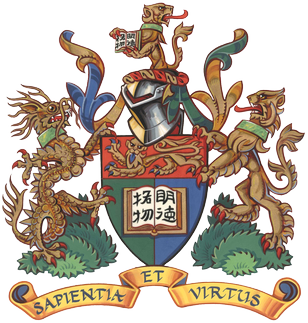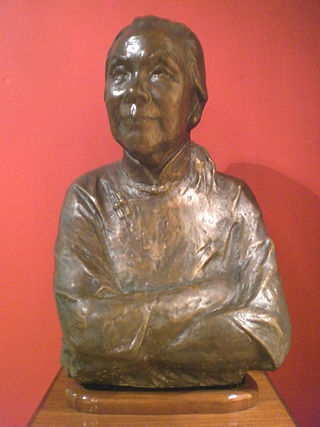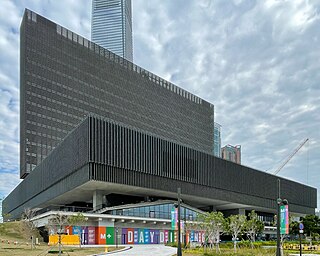
The University of Hong Kong (HKU) is a public research university in Pok Fu Lam, Hong Kong Island, Hong Kong.

The Chinese University of Hong Kong (CUHK) is a public research university in Sha Tin, New Territories, Hong Kong.
The culture of Hong Kong is primarily a mix of Chinese and Western influences, stemming from Lingnan Cantonese roots and later fusing with British culture due to British colonialism. As an international financial center dubbed "Asia's World City", contemporary Hong Kong has also absorbed many international influences from around the world. Moreover, Hong Kong also has indigenous people and ethnic minorities from South and Southeast Asia, whose cultures all play integral parts in modern-day Hong Kong culture. As a result, after the 1997 transfer of sovereignty to the People's Republic of China, Hong Kong has continued to develop a unique identity under the rubric of One Country, Two Systems.

Hong Kong Heritage Museum is a public museum of history, art and culture in Sha Tin, Hong Kong, located beside the Shing Mun River. The museum opened on 16 December 2000. It is managed by the Leisure and Cultural Services Department of the Hong Kong Government. The six permanent exhibits and the original temporary exhibits were designed by design firm Reich+Petch along with Lord Cultural Resources.

Mid-Levels is an affluent residential area on Hong Kong Island in Hong Kong. It is located between Victoria Peak and Central. Residents are predominantly more affluent Hong Kong locals and expatriate professionals.

The Hong Kong Museum of Art (HKMoA) is the first and main art museum of Hong Kong, located in Salisbury Road, Tsim Sha Tsui. It is a public museum managed by the Leisure and Cultural Services Department of the Hong Kong Government. HKMoA has an art collection of over 17,000 items. Admission is free for permanent exhibitions. Its rival is the non-government-managed Hong Kong Arts Centre. These two museums are considered to be the top two art museums in Hong Kong that dictate the discourse of art in Hong Kong.
Li Huasheng (1944–2018) was a Chinese artist from Yibin in Sichuan province. He received his first art training in one of Chongqing's culture halls. He met Chen Zizhuang in 1972, and studied traditional Chinese painting under him, mastering his style in just four years.

The University Museum and Art Gallery (UMAG) is located at 90 Bonham Road, next to the University of Hong Kong's East Gate entrance. Its exhibition galleries occupy the Fung Ping Shan Building as well as the first floor of the TT Tsui Building, where also the Museum Store is housed on the ground floor. The two buildings are joined by a bridge.

Hong Kong Arts Centre is a non-profit arts institution and art museum established in 1977. It promotes contemporary performing arts, visual arts, film and video arts. It also provides arts education. Its rival is the government-managed Hong Kong Museum of Art. These two museums are considered to be the top two art museums in Hong Kong that dictate the discourse of art in Hong Kong.
Jeffrey Shaw is a visual artist known for being a leading figure in new media art. In a prolific career of widely exhibited and critically acclaimed work, he has pioneered the creative use of digital media technologies in the fields of expanded cinema, interactive art, virtual, augmented and mixed reality, immersive visualization environments, navigable cinematic systems and interactive narrative. Shaw was co-designer of Algie the inflatable pig, which was photographed above Battersea Power Station for the 1977 Pink Floyd album, Animals.

Asia Art Archive (AAA) is a nonprofit organisation based in Hong Kong which focuses on documenting the recent history of contemporary art in Asia within an international context. AAA incorporates material that members of local art communities find relevant to the field, and provides educational and public programming. AAA is one of the most comprehensive publicly accessible collections of research materials in the field. In activating its collections, AAA initiates public, educational, and residency programmes. AAA also offers research grants and publishes articles on IDEAS Journal.
Liu Kuo-sung is a Chinese artist based in Taipei, Taiwan. Liu is widely regarded as one of the earliest and most important advocates and practitioners of modernist Chinese painting. He is also a writer on contemporary Chinese art.

Fang Zhaoling, also known as Lydia Fong, was a Chinese painter and calligrapher.
Irene Chou was a Chinese artist, one of the most influential exponents of the New Ink Painting movement in Hong Kong. A leader in the New Ink Painting Movement, Chou was at the forefront of reinventing traditional ink paintings into a contemporary art form. Her contribution to ink paintings has made an impact both regionally and internationally, making way for modern ink paintings in the global art scene.
Wong Chi Hang Sara is a Hong Kong-based visual artist and landscape architect. Wong graduated with a BA degree in Fine Arts from the Chinese University of Hong Kong in 1992 and an MA in Landscape Architecture from the University of Hong Kong.

M+ is an art museum in the West Kowloon Cultural District of Hong Kong. It exhibits twentieth and twenty-first century art encompassing visual art, design and architecture, and moving image. It opened on 12 November 2021.
Doris Wong Wai Yin, is a Hong Kong born artist, working with various types of media such as paintings, sculpture, collages, installations, videos and photography. Through her works, she explores her internal conflicts, raising and answering questions about her journey of motherhood, fears, and struggle with self-doubt.
The visual art of Hong Kong, or Hong Kong art, refers to all forms of visual art in or associated with Hong Kong throughout its history and towards the present. The history of Hong Kong art is closely related to the broader history of Chinese art, alongside the art of Taiwan and Macau. Hong Kong art may include pottery and rock art from Hong Kong's prehistoric periods; calligraphy, Chinese ink painting, and pottery from its time under Imperial China; paintings from the New Ink Painting Movement and avant-garde art emerging during Hong Kong's colonial period; and the contemporary art practices in post-handover Hong Kong today.
Sir Joseph Edward Hotung was a Hong Kong businessman, art collector, and philanthropist.











